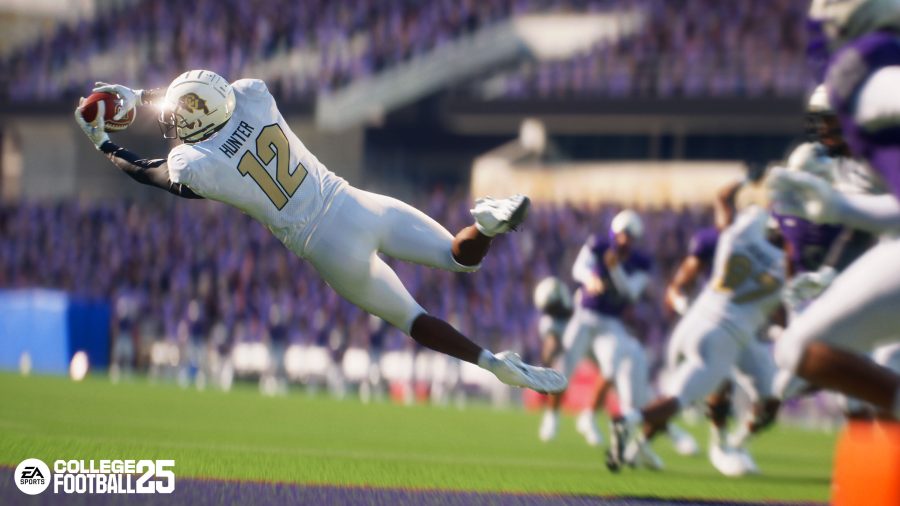Travis Hunter, the two-way player at receiver and defensive back for Colorado and one of three stars on the cover of College Football 25, spoke for a lot of gamers when he was asked what he thought of all the presentational elements and pizzazz put into the game that EA Sports invited him to play down at its Orlando, Fla. studio last week.
What’d you think of Folsom Field? Did the crowd sound the same? Did it feel the same? How about Ralphie the Buffalo running out? Hunter had a rather blithe, but nonetheless true answer.
“I was just trying to get to the gameplay,” he shrugged.
He simply buttoned through all the tradition and the pageantry that EA Sports had worked almost three years to build, and has spent a lot of time marketing to draw a crowd back to its first collegiate football video game in more than a decade.
And it’s totally OK. I’ll echo his sentiments. As much as the little fanfares — and in a game comprising 134 universities, there are thousands — are charming to anyone who gives any sentimental rip about college life, this game is still gonna live or die on how well it plays, like all video games do. And after a couple of hours on the sticks, I can give a confident thumbs up that it’ll be worthwhile, and distinct from its Madden NFL cousin, even if it borrows some core gameplay elements that the pro football version will show when it launches a month later.
For starters, players are getting a great spread of playbooks exemplary of collegiate football’s experimental approach to the game. The classic triple-option is joined by modern exponents such as Wake Forest’s long (or slow) run-pass option mesh, in addition to the usual spread-the-field, fire-drill nonsense.
All of this is supported by a gameplay engine that is smarter at contextualizing running behavior, allowing users quicker moves and cutbacks against blocking without triggering special moves on a face button or the right stick. Contextual running behavior — “getting skinny” when passing through the middle of the line-of-scrimmage battle, for example — is mainly applied to forward movement. Lateral motion, such as jukes and spins, are still on the user to execute to fake a tackler and continue on their way.
The best example I can give of this, I accidentally called a reverse pitch in one of my first three plays and was astonished to see an 8 yard gain out of a mistake play. Slow-to-develop plays, particularly behind the line of scrimmage, have long been a weakness in player-vs-CPU games like Madden NFL, which shares a core gameplay engine with College Football 25. But here, my split end had the ball before I even knew what was going on, much less the AI defense, and I still gaffed North Carolina for a 15-yard run by outrunning the coverage and picking a straight lane once I came around end. Go State!
That leads me to a second point: Madden NFL players are very familiar with the gratuitous stumble play, whereby someone is hit from the side, and his momentum stops, he stumbles into a long and unrecoverable animation, and while ostensibly still on his feet and capable of recovering, he’s slowed enough that someone else from the defense comes in to finish the job easily, as if he should have been tackled at the point where he was hit.
It’s not necessarily the case in College Football 25. If you want to take a runner out of the play, you have to hit him square, because recoveries and continuation from anything other than a full wrap-up tackle are now much more viable under the new engine they have running — and much more of which will be revealed when we get to Madden NFL 25 later. But for the version of football that lends itself to the option run, this is going to become very important.
Of course, execution will depend on how well a player reads the defense, and the positions that commit to one outcome of the play, and how to switch to the other outcome once they do. I haven’t run a true triple-option play, much less drawn back to pass in it, since NCAA Football 14 more than a decade ago, simply because the NFL does not play that style of football.
College Football 25 picks up where NCAA 14 left off
College Football 25 will be mainly supported by two persistent modes familiar to players of the old NCAA series: Dynasty, which is the control-everything coach career, and Road to Glory, which is a single-player mode akin to Madden’s Superstar.
Players of the original NCAA Football series will find mostly everything intact with Dynasty, in terms of the ability to alter conference alignments before beginning a playthrough, as well as the “coaching carousel” journey through it, which attempts to simulate the real-life forces of coaches leaving their schools — whether because they’re just that good and get plucked by bigger programs, or they fail expectations and get canned by the athletics office.
The difference in College Football 25 is that coaches will have to manage the “transfer portal” as ones do in real life. This means keeping stars happy, or shopping for them in the open market. It will add an additional wrinkle to what was already a unique personnel management system — based on AI players choosing a team, rather than a team choosing them. Coaches will be obligated to make promises to star players to keep them happy; fail those promises — especially if it concerns playing time — and they are likely to leave.
Transferring schools will be available to players in Road to Glory, the single-player career mode where one builds a superstar and a narrative of achievements for him. The limiting factor there is “coach trust,” a concept borrowed from the defunct NCAA Football series. Coach Trust does a number of things, beginning with creating a “position battle” for starter at your role, against the AI. From there it opens up the playbook and the ability to call more plays from it, or audible to different ones at the line of scrimmage. Moving schools inevitably resets that Coach Trust meter, forcing players to work more to get back on the field.
Created players in Road To Glory will not go through a high school playoff preamble, as they did in NCAA Football 14. However, the TeamBuilder web-based tool that supported that part of the mode will return, allowing players to create FCS (formerly Division I-AA) teams, fictitious teams, and other teams, and bring them to the ranks of major college football.
What is ‘Campus IQ’?
College Football 25 goes forth under a fan service mission that strives to attend to all 134 universities who participate in the Football Bowl Subdivision of the NCAA’s 1-A classification — basically, every school in major football. Campus IQ is a philosophy, more than it is a system or a set of assets. Basically, if your school plays at the top flight of college football, you can expect to hear its fight song, see its traditions observed, and view your home stadium, at minimum.
From there, it gets a little more sophisticated. Some schools have special days, like Penn State’s white-outs covering both bowls of Beaver Stadium. Others coordinate home games by section, advising fans to wear alternating colors according to the sections where they sit. These will be reflected in the game, along with any alternate uniforms and helmets the teams wear for such games.
Campus IQ also manifests itself in the pregame ceremonies, such as Ralphie the Buffalo’s run-out (mentioned above) but also players at Florida and Boston College rubbing their schools’ totems before they take the field, or Clemson running down the hill after touching Howard’s Rock.
The College Football 25 development team took it as a special mission to introduce all of these deeply personal features, said Rob Jones, the game’s senior production director.
“If a team like Insomniac making Spider Man 2 can actually rebuild all New York City, and make you feel like you’re going through New York,” he said, “then why can’t we replicate every single school faithfully so that people feel like we know them, and that we care as much about their school as we care about our own, right?”




















